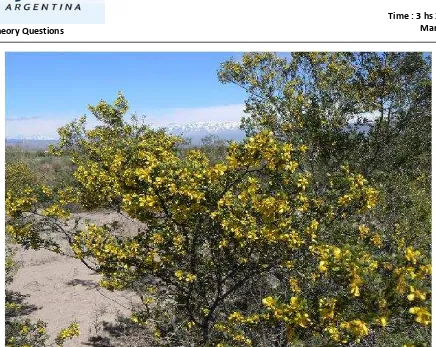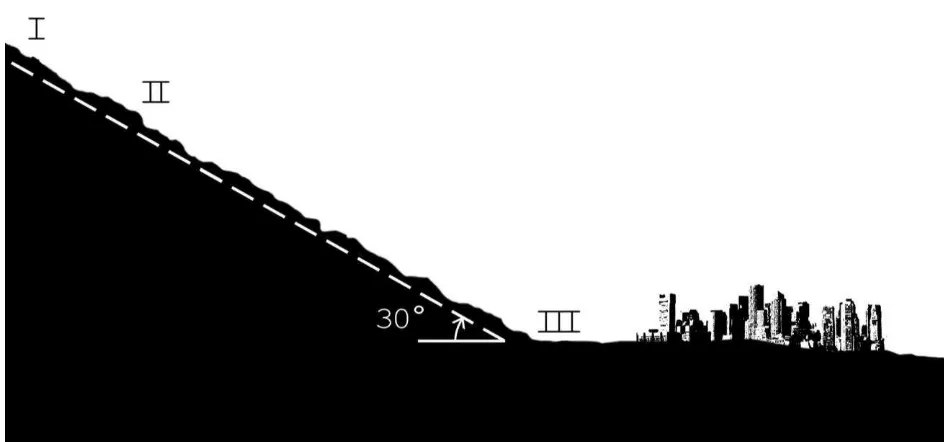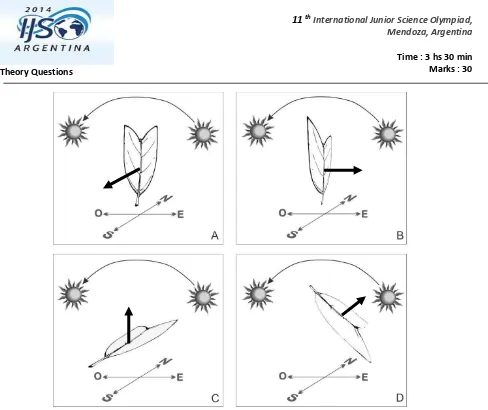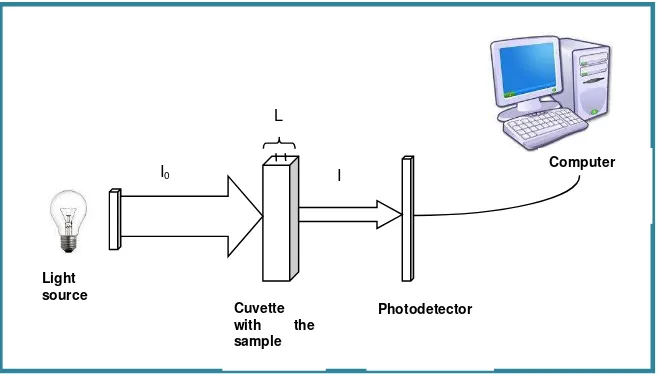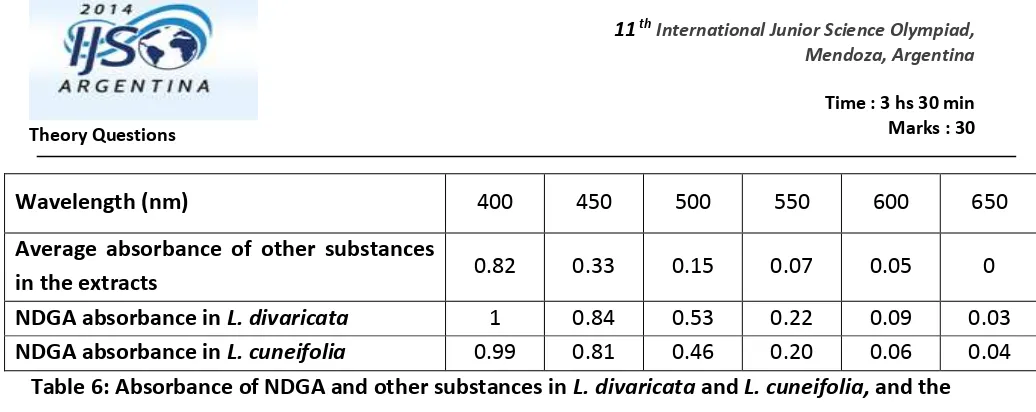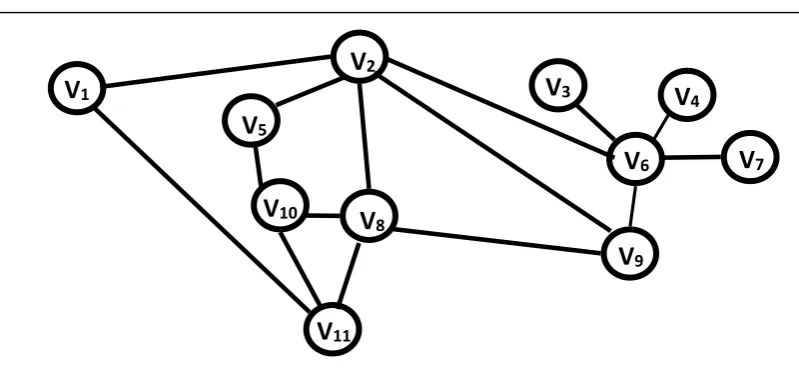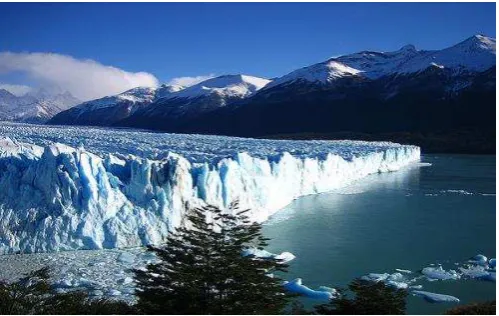11th International Junior Science Olympiad
Theory Questions
Page 2 of 27
EXAMINATION RULES
1. You have to sit at your designated desk.
2. Before the examination starts, you must check the stationery and any tools (pen, ruler, calculator) provided by the organizers.
3. You are not allowed to bring any tools except personal medicine or approved personal medical equipment.
4. You have to check the Question and Answer Sheets provided. Raise your hand, if you find any missing sheets. Start tasks after the start whistle is blown.
5. During the examination, you are not allowed to leave the examination room except in an emergency. If such is the case, you will be accompanied by a supervisor/volunteer/invigilator.
6. You are not to disturb other competitors. If you need any assistance, you may raise your hand and wait for a supervisor to come and assist you.
7. There will be no discussion about the examination tasks or problems. You must stay at your desk until the examination is over, even if you have finished it.
Page 3 of 27
READ THE FOLLOWING INSTRUCTIONS CAREFULLY
1. The time available is 3 hours and 30 minutes.
2. Check that you have a complete set of test questions and Answer Sheets. The total number of questions is 3 (26 pages).
3. Write down your ID code on each page of your answer sheet.
4. Write your final answer in the smaller box provided. Write the steps clearly in the larger box.
To calculate 4-2.5, do the following 1) Press 4
2) Press yx (just above number 8) key
3) Press 2.5
Page 4 of 27
PROBLEM 1
The rapid increase in world population (currently of over 6700 million people) and the methods we have employed to extract, transport, transform, and use our resources are making our planet increasingly smaller and less sustainable for its inhabitants. During the last few years, global environmental changes have gained much importance due to a series of impacts that have been registered. Although the varied chemical, physical, and biological components interacting in our world have always been subject to change, the consequences of human activity have played, in the last century, a fundamental role in determining the nature of these changes.
A team of environmentalists of a non-governmental organization (NGO), and associated with the Ministry of Environment, have set among its goals, to divulge and assess the ecosystemic importance of the genus Larrea, (an Argentine plant species) which is widely distributed throughout the country. The NGO identifies its uses as:
1. Implementation in vegetative coverings of lands disturbed by human activity. 2. Social and cultural importance as a native species.
3. Applications in cosmetics and medicine, among others. 4. Use as ground hardener in areas prone to collapses.
The Larrea genus, of the Zygophyllaceae family (common local a e: ja illa , i ha its a id areas. There are four species in Argentina: Larrea cuneifolia, L. divaricata, L. nitida y L. ameghinoi. Its lea es a e oated a esi o posed i its g eatest p opo tio C H O ,
Page 5 of 27
1.1. In order to justify the use of Larrea as a native species for the revegetation of disturbed areas, a group of researchers worked in an area affected by mining activity. They proceeded as follows:
Two sample sites were chosen within the affected region. One of them was revegetated with
Larrea, while the other one was left to natural succession. Ten years later, the two sites were sampled.
Since Larrea species modify the conditions under their coverage, favoring the colonization of other species; the goal of this test was to determine if the diversity of species observed in the community reflected this favored tendency for colonization.
Species diversity is an emergent property of biological communities, and can be measured by: 1. Species richness (S): number of different species in the community.
2. Species evenness or equitability: proportion of all individuals belonging to each species (relative abundance).
Page 6 of 27
The Pielou index (J) is one of the indexes used to measure evenness and it is given by this equation:
max
'
'
H
H
J
Being:
H’ the Shannon- Wiener index (values are shown in table 1 and 2 on the next page)
max
H' = ln(S) S: species richness
Remember that:
Page 7 of 27
The data obtained from each sample is shown in the following tables and graphs:
Table 1: Species, Abundance and Forms of Life in the Community revegetated with Larrea (Sample site 1)
Page 8 of 27
1.1.1. Fill in Table 3 in the Answer sheet with the information related to each community.
Community
1.1.2. Indicate which community has a greater biological diversity.
1.1.3. Mark true (T) or false (F) appropriately for each explanation shown on the Answer Sheet, in order to justify the answer given in 1.1.2.
A. After ten years, the community left to natural succession and the community revegetated with Larrea exhibited a wide large difference in species richness, to Larrea spp.’s fa ilitati g effe t.
B. The presence of Larrea in sample 1 increased the abundance of shrubs and herbaceous forms. This could indicate that Larrea favors the development of other species, augmenting the diversity of this community.
C. The favoring effects are indicating that the revegetated community (sample site1) presents less diversity of forms of life than the community left to natural succession (sample site 2).
Page 9 of 27
Figure 4: Schematic representation of the region to be revegetated.
1.3. Another difficulty generated by the loss of natural flora, mainly in terrains with a slope, is the detachment and consequent falling of rocks. A side-view of a foothill in Mendoza is shown on Figure 5.
1.3.1. While carrying out their revegetation duties, a group of workers located at point I notice a rock sliding (without rotating) down the hillside, with a velocity of 10.0 m s-1. From point
I to point II there is a distance of 50.0 m, and the kinetic coefficient of friction between the rock and the ground in that stretch is 0.46. Neglecting air resistance, and assuming, the surfaces is
Figure 5: Side-view of the terrain.
r1 r1
r1
r2 r2 r2 60
Page 10 of 27
flat, find the velocity of the rock when it passes point II. (Acceleration due to gravity: 9.81 m s-2)
1.3.2. The presence of vegetation helps to prevent rock detachment, and to stop the rocks from sliding if they are detached. Suppose the 200.0 m stretch from point II to point III has been revegetated, and that the rock from exercise 1.3.1 reaches point III with zero velocity. Find the kinetic friction coefficient of this stretch, assuming it is constant throughout it.
1.4. In order to improve the condition of the soil, the researchers performed chemical analyses on the disturbed soil and determined the optimum values that Larrea spp. need for their development.
The results are shown on Table 4.
Varia les Co positio of distur ed
Page 11 of 27
a ou t of fe tilize to e used.
. . . Co pute ho a kilog a s of fe tilize ust e added pe s ua e ete s of te ai . Rou d esults usi g t o de i al afte the u it.
1.4.3. Determine the concentration of hydroxide ions (OH)1- responsible for the pH value measured in the disturbed soil shown in Table 4.
1.4.4. Indicate which of the pH indicators shown in Table 5 you would choose to determine qualitatively the disturbed soil pH, and what color the chosen indicator would take. Write the indicator and the color using the code in parentheses)
I di ator pH i ter al Color
. . .The pH of the soil can be high in regions of elevated concentrations of soluble Na2CO3 salt (sodium carbonate) and poor precipitation. This is due to the hydrolysis reaction between the carbonate ion and H2O (water).
W ite the ala ed he i al e uatio fo the total io izatio ea tio of Na CO i ate .
. . . W ite the ala ed io i h d ol sis e uatio that justifies the pH ele atio i the soil due to the a o ate io .
Page 12 of 27
Figure 6: Larrea cuneifolia leaves with different orientations.The arrows show the normal direction of the upper surface of the leaf.
1.5.1. Indicate which one illustration best expresses the description given in 1.5.
1.5.2. Select from the following options the statement that provides the reason to the answer to 1.5.1:
a) The wavelength of the light emitted by the Sun is different at different times during the day
b) The frequency of the light emitted by the Sun is different at different times during the day
The su fa e of the leaf e posed pe pe di ula l to the “u ’s adiatio at diffe e t times during the day
Page 13 of 27
1.6. The nordihydroguaiaretic acid (NDGA) (C H O ), present in the resin of Larrea leaves, has many uses in cosmetics and medicinal industries due to its properties as an antioxidant, anticarcinogen and antiviral.
A method to identify this acid is based on its reaction with ammonium molybdate tetrahydrate ((NH4)6Mo7O24.4H2O) to produce an orange colored complex. The absorbance of an incident ray of light of certain wavelength is measured after it traverses a sample of the colored solution placed in a transparent cuvette as shown in Figure 7. The absorbance will depend directly on the concentration of the colored complex present in the solution, which absorbs radiation at that particular wavelength.
Figure 7: Schematic setup for the measurement of absorbance
In the process of extraction of NDGA from the leaves of Larrea sp., other substances are extracted together with it. These substances interfere with the quantitative determination of NDGA. Since they have some functional groups in common with NDGA, they react with the ammonium molybdate producing the colored complex.
Alcohol extracts were obtained from the leaves of L. divaricata and L. cuneifolia. Absorbance measurements were performed on them at different wavelengths, using the ammonium molybdate method. The results are shown on Table 6.
Page 14 of 27
Wavelength (nm) 400 450 500 550 600 650
Average absorbance of other substances
in the extracts 0.82 0.33 0.15 0.07 0.05 0
NDGA absorbance in L. divaricata 1 0.84 0.53 0.22 0.09 0.03 NDGA absorbance in L. cuneifolia 0.99 0.81 0.46 0.20 0.06 0.04
Table 6: Absorbance of NDGA and other substances in L. divaricata and L. cuneifolia, and the corresponding wavelengths.
1.6.1. Draw a Cartesian graph of comparative lines for absorbance as a function of wavelength for the three samples, based on Table 6. Use different colors for each type of absorbance line.
1.6.2. Using the information given in Table 6, indicate the wavelength that is needed to best distinguish NDGA from other substances. cuneifolia, but forgot to label them. He decided to place them in two vessels labeled A and B, and measured the absorbance of each sample at 500 nm using a cuvette of 1 cm optical travel length.
With ε = 8 920 M-1 cm-1 and the molar mass of NDGA being 302 g mol-1, the absorbance for extract A was 0.47, while the absorbance for sample B was 0.52.
1.6.3. Calculate the NDGA concentration (mg L-1) in each extract. Consider the extract was purified from other substances.
Page 15 of 27
1.6.5. A 500 ml aqueous solution at 0.2% w/v of NDGA is to be prepared from L. divaricata
Page 16 of 27
PROBLEM 2
Climate change is understood as a long-term change in the average weather conditions produced by nature and/or human activity. It is currently an environmental issue of major worldwide concern.
Some of the topics related to climate change that are causing concern in the scientific community include:
a. Acid rain affecting the fresh water reservoirs of the planet, and generating conflicts in the distribution of water to human population.
b. Melting glaciers as a direct consequence of a global rise in temperature.
The increased concentration of certain gases in the atmosphere, such as the so-called Greenhouse Gases (GG) among which we find carbon dioxide (CO2), methane (CH4), and nitrogen dioxide (NO2), is a result of human activity associated with the use of fossil fuels, intensive agriculture, and soil alteration. The accumulation of these gases has produced a rise in the
a e age te pe atu e of the ea th’s su fa e k o as Glo al Wa i g . A othe o se ue e
of the greater concentrations of GG together with sulfur dioxide (SO2), is the formation of a type of precipitation known as acid rain, which is also naturally produced by volcanic eruptions and thermal springs. The harmful effects of low pH levels in aquatic ecosystems are immediate and it also has other consequences such as the deterioration of construction materials, sculptures and stone monuments. Besides, acid rain dissolves metals such as lead (Pb), and copper (Cu) present in water pipes. Nevertheless, sulfur in acid rain may have benefits. Sulfur dioxide is converted into sulfate aerosols that enhance the reflection of solar radiation and also limits global warming by counteracting the natural production of methane gases by microbes in wetland areas; and thereby tending to cool Earth's surface.
Page 18 of 27
. . . Dete i e the a i u u e of pipes that a e e o ed ithout i te upti g the ate suppl i e e dist i utio poi t.
2.4. Lead accumulates in the body and normally affects the liver, the kidneys, and the nervous system. Its excessive ingestion affects the neurological system, resulting in mental retardation, low average growth heights and disruptions in daily activity. Even low quantities of absorbed lead can result in damages to the central nervous system of small children and fetuses.
The toxic levels of lead in blood for adults range from 0.038 mg/100 ml upward, while in children it starts at 0.005 mg/100 ml. The levels of lead concentration obtained from blood tests of 5 adults (sample 1) and 5 children (sample 2) of the city under discussion are shown on the following table7.
Sample Blood lead concentration (mg/100 ml)
1. Adults 0.057 0.020 0.087 0.060 0.065
2. Children 0.004 0.010 0.009 0.008 0.007
Table 7: Blood lead concentration (mg/100 ml) in adults and children.
2.4.1. Compute the average value of lead in blood for each sample. Indicate which of them, if any, is above the toxicity levels, writing an A for adults, a C for children and a B for both
Page 19 of 27
2.5. Life on Earth is made possible by the energy it receives from the Sun, and by the presence of the Greenhouse Gases, which absorb the infrared radiation emitted by the surface of the Earth. Part of this absorbed radiation is reemitted to the upper parts of the atmosphere, while another part is reemitted to the surface of the Earth increasing its average temperature.
Figure 9. a) ithout at osphere. ) ith at osphere
The surface of the Sun radiates energy as a black body at a temperature of 5500°C. A black body is an object that absorbs all the energy of the incident radiation. Part of this energy reaches the top of the Ea th’s at osphe e with an average incoming intensity of approximately 341W m-2 over the whole surface of the atmosphere. Thirty percent (30%) of this intensity is reflected back to space and the rest is absorbed by the surface of the Earth, which reemits it at larger wavelengths (infrared radiation).
2.5.1. Calculate Ea th’s e uili iu te pe atu e ithout the absorption of the atmosphere (Figure 9a). Express your results in K and °C.
The intensity I (W m-2) radiated by a black body follows Stefan-Boltz a ’s La : I = σT4, whereσ = 5,67x10-8W m-2 K-4
Assume that the Earth radiates energy as a black body.
Page 20 of 27
Find the equilibrium temperature of the Earth with the atmosphere (Figure 9b), assuming that the atmosphere absorbs all the radiation emitted by the surface, and reemits it back to both the Earth and Space in equal proportions. Start out with intensity balance on the Earth surface and on the atmosphere.
Hint:
Assume that the atmosphere only absorbs energy from the Earth surface, and that both emit energy as a black body.
2.6. One of the theories concerning climate change affirms that the planet is warming due to the Greenhouse Effect, and this in turn is causing the melting of glaciers.
Figure 10: Glacier Perito Moreno, Santa Cruz, Argentina
2.6.1. In this context, calculate the minimum amount of energy needed to completely melt a block of 10 000 kg of ice, initially at -10°C.
Thermodynamic constants:
Page 21 of 27
PROBLEM 3
Sports physiology studies the responses and adaptations of the human body to physical effort. These responses and adaptations vary depending on multiple factors such as the intensity, duration or frequency of physical activity performed; or others, such as diet, environmental conditions or genetic inheritance of each individual.
A 13 year old teenager enjoys physical activity. For several months, she has been training for an athletic competition. Today she got up early and had breakfast, which consisted of a cup of milk, a slice of toast and a banana.
3.1. Carbohydrate digestion results in the catabolism of the large molecules into simpler molecules. The enzymes contained in the body catalyze this transformation.
3.1.1. Based on the information shown on Table A and Table B, mark with a cross (X) on Table A the secretory structure which produces the enzyme involved in digesting the starch that is present in the slice of toast. Then, use the corresponding number given to the enzyme shown on Table B, to match the Structure where this enzyme is produced.
Hint: the same enzyme may be produced by more than one structure.
3.1.2. At breakfast, she also incorporated carbohydrates from milk and fruit that in the digestive process will be split into simpler sugars due to the activity of specific enzymes.
Page 22 of 27
Fill in Table C (indicated on the Answer Sheet) which shows enzymatic reactions. Write the corresponding letter of the enzyme in the green box and the corresponding number for the products in the blue boxes (each number may be used more than once).
ENZYMES PRODUCTS
After breakfast, the athlete goes to the sports field for her daily workout routine. If we study in detail the movement of the athlete and the processes involved in the musculature, we can say:
3.2. . Musculature together with the skeletal system it forms the musculoskeletal system, which is responsible for movement of the human body. The mechanism of muscular contraction can be
e plai ed a o de ed se ue e of p o esses .
3.2.1 Table D shows muscular contraction processes. Complete Table E (indicated in Answer Sheet), indicating the letter of the process in the order in which they occur.
Table D: Processes of muscle contraction
A. ATP is hydrolyzed to ADP + Pi (inorganic phosphorus) and the myosin head is separated from the active site.
B. Acetylcholine acts on a local area of the sarcolemma to open multiple membrane protein channels. This allows the entry of large amounts of sodium ions into the sarcolemma, which initiates an action potential in the muscle fiber.
Page 23 of 27
C. The action potential depolarizes the sarcolemma. The release of Ca++ ions from the sarcoplasmic reticulum occurs.
D. Ca++ ions are pumped back into the sarcoplasmic reticulum, where they remain until the arrival of a new action potential to the muscle.
E. An action potential reaches the neuromuscular junction (synapse) of a motor neuron and a muscle, acetylcholine is released from the axon terminal.
F. Ca++ ions initiate attractive forces between the actin and myosin. Filaments of myosin and actin are arranged next to each other within the sarcomere so that that they can interact in an organized fashion resulting in muscle contraction. During contraction, myosin heads bind actin and pull the filaments in towards the center.
Tabla E
ORDER CORRESPONDING
LETTER
1
2
3
4
5
6
Page 24 of 27
The contraction of skeletal muscle, involves multiple simultaneous shortening of sarcomeres. This means that the sliding of actin and myosin filaments occurs, making them work as an engine. For this process to occur, mechanical forces and energy are required. The forces are generated by the filament cross-bridges and the energy comes from the hydrolysis of ATP to ADP + Pi.
3.3 As part of her daily training, the athlete also performs a weight lifting routine in order to strengthen her muscles.
3.3.1. The typical maximum force of an "engine" of myosin-actin as those found in muscles, is 5.0x10-12 N. Calculate the minimum amount of "engines" a muscle should utilize in lifting a mass of 50 kg. (Acceleration of gravity: 9.81 m s-2)
3.3.2. These engines consume ATP. The typical force exerted by a myosin engine is 5x10-12 N, and its typical speed is about 11x10-9 m s-1. Calculate the power developed by the myosin engine measured in J s-1.
Page 25 of 27
3.4. Different foods provide the organism with different amounts of energy to carry out its functions. The combustion equation of glucose (C6H12O6) is one of those most frequently used to describe this process.
3.4.1. If the food ingested at breakfast by the athlete is equivalent to 90 g of glucose, calculate the mass of carbon dioxide (CO2) produced as a result of complete combustion. (Relative atomic mass C= 12; O=16; H=1).
3.4.2. Calculate the number of oxygen atoms in 90 g of glucose molecules.
3.5. Then the athlete decides to do a short speed test in a straight line first and then in a circular movement.
3.5.1. During her straight line path, her velocity follows the graph as shown in the figure below. Find the instantaneous acceleration at points A, B and C.
Figure 12: Velocity as a function of time
Page 26 of 27
3.5.3. The circular path starts at t= 4 s, with the speed shown in Figure 12. The limiting force friction between the footwear and the ground of the athlete does not allow her to have more than 3.0 m s-2 centripetal acceleration. Calculate the minimum radius of her circular path. Consider a constant speed along the whole path.
3.6. Before starting with her physical activity, the athlete underwent a medical checkup. The pressure and volume for different parts of the heart in relation with time, as well as an electrocardiogram and phonocardiogram are illustrated in Figure 13.
Page 27 of 27
3.6.1. Using the information shown in the graph, compute the time period of one cardiac cycle (in seconds).
3.6.2. Calculate the corresponding heart rate (cardiac cycles per minute).
3.6.3. Indicate in which time intervals ventricular volume decreases considering that intervals in which the volume remains constant last 0.05 seconds.
3.6. 4. Indicate the maximum value observed for ventricular pressure.
. . Afte ph si al a ti it the athlete felt e essi el agitated, so she de ided to ask so eo e to take he pulse. At that ti e o o e had a at h, ut a Ph si s stude t said that he ould do it i p o isi g a si ple pe dulu a d aki g it os illate slightl a ou d its e uili iu positio Figu e . E e o plete les of the pe dulu , the stude t easu ed eats a d fou d that the hea t f e ue of the athlete as t i e the o e e o ded i the p e ious e e ises f e ue al ulated i poi t . . .
. . . Cal ulate the length of the pendulum used by the student, the pe iod of si ple pe dulu is gi e � = 2�√��
Bei g:
L the le gth of the pe dulu g= .
